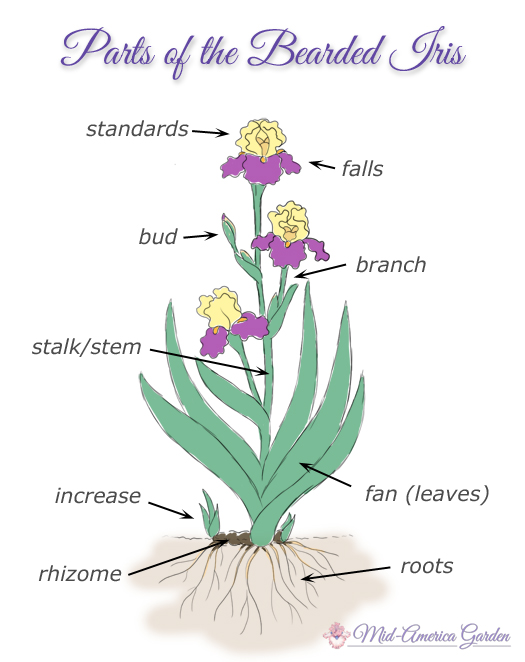Symbols & Terminology
IRIS CLASSIFICATION
-
TB - Tall Bearded: over 27.5 inches tall, mid to late spring bloom
-
BB - Border Bearded: 16 to 27.5 inches tall, smaller versions of the TB, bloom with the TBs in mid to late spring
-
MTB - Miniature Tall Bearded: 16 to 27.5 inches tall, smaller flowers and slim stems, mid to late spring bloom with the TBs
-
IB - Intermediate Bearded: 16 to 27.5 inches tall, early to mid spring bloom, overlapping the SDBs and the TBs
-
SDB - Standard Dwarf Bearded: 8 to 16 inches tall, early spring bloom
-
MDB - Miniature Dwarf Bearded: up to 8 inches tall, the first of the bearded irises to bloom in very early spring
-
AB and ABM - Arilbred and Aril-Median: these are a cross between Aril and Bearded irises, ranging from 3 to over 30 inches tall, blooming with the corresponding size bearded irises
-
For: foreign import
-
Seedling (SDLG): a variety of iris that is still under evaluation and has not yet been introduced and named. These are grown from seeds, breedings deliberately pollinated by the hybridizer. You will see "Sdlg" in many descriptions for those who are interested in an iris's lineage.

PARTS OF THE IRIS
-
Beard: fuzzy raised projections in the upper center of the falls
-
Branch: a branch off the main flower stalk
-
Falls (F): the three lower petals of the iris flower, down-turned or horizontally flared
-
Fan: a set of leaves, fan-like in shape
-
Flounces: petal-like appendages that emerge from the end of the beard in some varieties
-
Form: the balance and proportions of the flower
-
Hafts: upper part of the falls, on each side of the beard
-
Horns: a pointed appendage extending from the end of the beard, often pointed upward
-
Increase: new plants emerging from the side of the rhizome
-
Lace: serrations on the outer edges of the petals
-
Midrib: stiffened central rib on each standard
-
PBF: purple based foliage
-
Rhizome: fleshy brown horizontal tuber-like underground stem, from which the roots and leaves grow
-
Ruffles: fluted or wavy petal edges
-
Shoulders: the areas on the arched middle part of the falls, outward from the hafts
-
Signal: a patch of contrasting color surrounding the beard, emanating from the throat
-
Space Age (SA): varieties of irises that have flounces, spoons, or horns
-
Spathe: modified leaves that cover the emerging buds, becoming brown and papery
-
Spoons: spoon-shaped appendages extending from the end of the beard
-
Stalk (Stem): stiff stem from which the flowers grow, may have branches with additional flowers
-
Standards (S): three upturned petals that surround the three style arms
-
Style Arm: three small stiff crested structures above the beards, interior to the standards
-
Substance: the strength and thickness of the petals
-
Texture: the finish or sheen of the petals
-
Variegated: foliage is that patchy green and white colored instead of the typical solid green


BLOOM SEASON
Bear in mind that spring is the bloom season, and exact months will vary by location.
-
VE : very early season bloom
-
E: early season bloom
-
EM: early midseason season bloom
-
EML: early-mid-late season bloom
-
M: mid season bloom
-
ML: late midseason season bloom
-
L: late season bloom
-
VL: very late season bloom
-
RE: reblooming: can produce more than one crop of bloom stalks within a growing season
COLORS & PATTERNS
-
Amoena: white or near-white standards, and colored falls
-
Bicolor: standards and falls are two different colors
-
Bitone: the standards are a lighter tint of the color (hue) of the falls
-
Blend: combination of two or more colors blended together, whether smoothly or unevenly
-
Broken: random pattern or splotchy or streaked colors
-
Glaciata: irises lacking the purple anthocyanin pigment; bright glowing white, yellow, pink, or orange
-
Ground Color: base color of a petal, usually in reference to plicata, under the dots or peppering
-
Lines/Lined: veins that are a contrasting color or darker than the ground color of the petal
-
Luminata: white or yellow base color washed over with a darker color, style arms and hafts white or yellow, pale veining, usually pale edges on petals, appears to glow from within
-
Neglecta: light blue or purple standards; falls of the same color (hue) but a darker shade
-
Peppering: dotted or stippled markings contrasting with a lighter ground color, as in plicatas
-
Plicata (Plic): stippled, dotted, peppered, or stitched markings contrasting with a lighter ground color
-
Reverse Amoena: colored standards, and white or near-white falls
-
Reverse Bitone: standards are a darker shade of the same color (hue) of the falls
-
Rim: a thin edge of color around the petals
-
Self: an iris with all petals of one solid color
-
Signal: a patch of contrasting color at the end of the beard, such as with arilbred irises
-
Spot: a contrasting color area on the falls, which may cover most of the falls
-
Stippled: dotted, peppered, or dashed
-
Variegata: yellow or near-yellow standards, with darker falls (usually red or purple or brown)
-
Veined: lines that are a contrasting color or darker than the ground color of the petal
-
Wire Edge: an extremely thin edge of colors around the petals
-
Zonal: white or light colored area around the beards in the middle of the falls